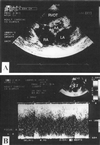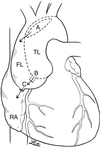Aorto-right artrial fistula: a rare complication of aortic dissection
- PMID: 10830634
- PMCID: PMC101024
Aorto-right artrial fistula: a rare complication of aortic dissection
Abstract
We describe the successful surgical repair of an acute aortic dissection that had caused an aorto-right atrial fistula in a 67-year-old man. The patient was admitted to the hospital on an emergency basis because of severe heart failure. The diagnosis of acute aortic dissection with rupture into the right atrium was confirmed by use of intraoperative transesophageal echocardiography, although rupture of a sinus of Valsalva aneurysm into the right atrium had been suggested initially by 2-dimensional and Doppler transthoracic echocardiography. At surgery, we found the patient to have aortic arch dissection with complete separation of the right coronary artery from the sinus of Valsalva and a false lumen that had ruptured into the right atrium. The aortic arch was repaired directly. The ascending aorta was successfully replaced with a composite graft. Aortic dissection with rupture into the right atrium is extremely rare and leads to death rapidly. As shown in this case, such a condition might be mistaken for an aneurysmal rupture of the sinus of Valsalva, with use of transthoracic echocardiography alone. Transesophageal echocardiography is a useful noninvasive method to further define or confirm the diagnosis. Early surgical intervention is necessary in patients with this condition to prevent profound shock and end-organ failure.
Figures


References
-
- Kuipers FM, Schatz IJ. Prognosis in dissecting aneurysm of the aorta. Circulation 1963;27:658–61.
-
- Temple TE Jr, Rainey RL, Anabtawi IN. Aortico-atrial shunt due to rupture of a dissecting aneurysm of the ascending aorta. J Thorac Cardiovasc Surg 1966;52:249–54. - PubMed
-
- Hurley DV, Nishimura RA, Schaff HV, Edwards WD. Aortic dissection with fistula to right atrium. Noninvasive diagnosis by two-dimensional and Doppler echocardiography with successful repair. Case report and review of the literature. J Thorac Cardiovasc Surg 1986;92:953–7. - PubMed
-
- Berman AD, Come PC, Riley MF, Weintraub RM, Johnson RG, Aroesty JM. Two-dimensional and Doppler echocardiographic diagnosis of an aortic to right atrial fistula complicating aortic dissection. J Am Coll Cardiol 1987;9:228–30. - PubMed
Publication types
MeSH terms
LinkOut - more resources
Full Text Sources
Medical
Research Materials
